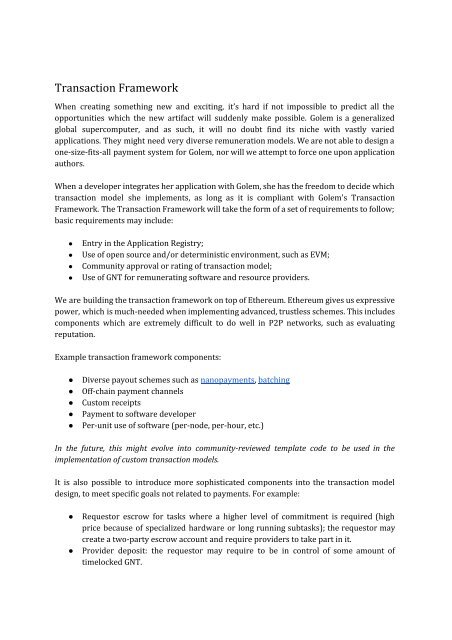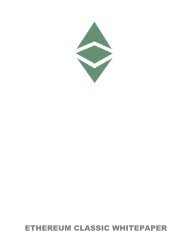whitepaper - golem with cover
Create successful ePaper yourself
Turn your PDF publications into a flip-book with our unique Google optimized e-Paper software.
Transaction Framework<br />
When creating something new and exciting, it’s hard if not impossible to predict all the<br />
opportunities which the new artifact will suddenly make possible. Golem is a generalized<br />
global supercomputer, and as such, it will no doubt find its niche <strong>with</strong> vastly varied<br />
applications. They might need very diverse remuneration models. We are not able to design a<br />
one-size-fits-all payment system for Golem, nor will we attempt to force one upon application<br />
authors.<br />
When a developer integrates her application <strong>with</strong> Golem, she has the freedom to decide which<br />
transaction model she implements, as long as it is compliant <strong>with</strong> Golem's Transaction<br />
Framework. The Transaction Framework will take the form of a set of requirements to follow;<br />
basic requirements may include:<br />
●<br />
●<br />
●<br />
●<br />
Entry in the Application Registry;<br />
Use of open source and/or deterministic environment, such as EVM;<br />
Community approval or rating of transaction model;<br />
Use of GNT for remunerating software and resource providers.<br />
We are building the transaction framework on top of Ethereum. Ethereum gives us expressive<br />
power, which is much-needed when implementing advanced, trustless schemes. This includes<br />
components which are extremely difficult to do well in P2P networks, such as evaluating<br />
reputation.<br />
Example transaction framework components:<br />
●<br />
●<br />
●<br />
●<br />
●<br />
Diverse payout schemes such as nanopayments, batching<br />
Off-chain payment channels<br />
Custom receipts<br />
Payment to software developer<br />
Per-unit use of software (per-node, per-hour, etc.)<br />
In the future, this might evolve into community-reviewed template code to be used in the<br />
implementation of custom transaction models.<br />
It is also possible to introduce more sophisticated components into the transaction model<br />
design, to meet specific goals not related to payments. For example:<br />
●<br />
●<br />
Requestor escrow for tasks where a higher level of commitment is required (high<br />
price because of specialized hardware or long running subtasks); the requestor may<br />
create a two-party escrow account and require providers to take part in it.<br />
Provider deposit: the requestor may require to be in control of some amount of<br />
timelocked GNT.
















